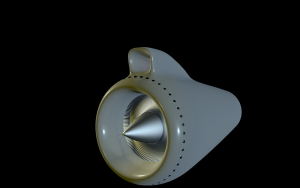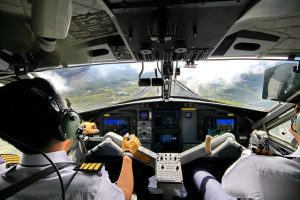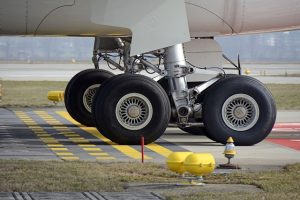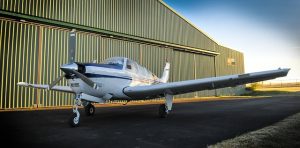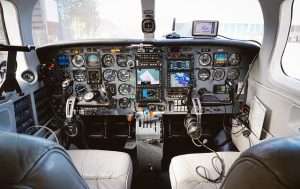
As most seasoned pilots know, activating the ignition switch is one of the first steps to taking off from the runway. It’s the equivalent of inserting and turning a key in the ignition of an automobile. The ignition switch will essentially start the airplane’s engine or engines. For a better understanding of this essential aircraft control mechanism and how it works, keep reading.
What Is the Ignition Switch?
The ignition switch is a control mechanism found in the cockpit of most airplanes that provides the initial jolt of electricity needed to start the engine or engines.
Jet-powered airplanes use a combustion process to generate thrust. They burn a mixture of fuel and air, and they expel the exhaust gases out of a nozzle. This combustion process will propel the airplane forward. For the combustion process to occur, however, there needs to be a spark, which is where the ignition switch comes into play.
How the Ignition Switch Works
There are different types of ignition switches, but most of them work in conjunction with a magnetos. A magnetos is a generator that uses a built-in magnet to generate an electrical current. When the ignition switch is activated, the airplane’s engine or engines, as well as the magnetos, will turn on.
The ignition switch typically supports several different positions. The “off” position means the airplane’s ignition system is completely deactivated. The engine or engines won’t receive the initial jolt of electricity they need to complete the combustion process, so the airplane will remain grounded.
The “start” position, on the other hand, activates the airplane’s ignition system. Pilots must turn the ignition to this position during the startup sequence.
There’s also the “ignition” position. Not to be confused with the “start” position, the “ignition” position generates the actual spark. It will ignite the combination of fuel and air within the engine cylinders, thus allowing for combustion.
Spark Plugs and the Ignition Switch
It’s important to note that most airplanes have spark plugs — just like automobiles. The ignition switch simply provides the spark plugs with the electrical current needed to perform their job.
Activating the ignition switch in an airplane will provide a jolt of electricity to the spark plugs. From there, the spark plugs will send the electricity to the engine cylinders so that the mixture of fuel and air will ignite. Most airplanes have several spark plugs per engine cylinder. Therefore, if one of the spark plugs fails, there’s typically at least one other spark plug to keep the cylinder running.
- SEO Powered Content & PR Distribution. Get Amplified Today.
- PlatoData.Network Vertical Generative Ai. Empower Yourself. Access Here.
- PlatoAiStream. Web3 Intelligence. Knowledge Amplified. Access Here.
- PlatoESG. Carbon, CleanTech, Energy, Environment, Solar, Waste Management. Access Here.
- PlatoHealth. Biotech and Clinical Trials Intelligence. Access Here.
- Source: https://monroeaerospace.com/blog/understanding-the-ignition-switch-and-how-it-works/
- :is
- :not
- :where
- 300
- a
- activated
- activating
- actual
- AIR
- aircraft
- Airplane
- Airplanes
- Allowing
- also
- an
- and
- ARE
- AS
- At
- automobile
- automobiles
- BE
- Better
- built-in
- burn
- but
- Cockpit
- combination
- comes
- complete
- completely
- confused
- conjunction
- control
- Current
- different
- during
- electricity
- Engine
- Engines
- Equivalent
- essential
- essentially
- fails
- First
- first steps
- For
- Forward
- found
- from
- Fuel
- generate
- generates
- generator
- grounded
- hand
- Have
- High
- How
- However
- HTTPS
- if
- Ignite
- Ignition
- important
- in
- initial
- into
- IT
- Job
- jpg
- just
- Keep
- Key
- Know
- least
- like
- max-width
- means
- mechanism
- mixture
- most
- must
- Need
- needed
- needs
- note
- occur
- of
- off
- on
- ONE
- or
- Other
- out
- per
- perform
- Pilots
- plato
- Plato Data Intelligence
- PlatoData
- Play
- plug
- position
- positions
- process
- Propel
- provide
- provides
- Reading
- receive
- remain
- running
- runway
- seasoned
- send
- Sequence
- several
- simply
- So
- Spark
- start
- startup
- Steps
- Supports
- Switch
- system
- taking
- that
- The
- their
- Them
- There.
- therefore
- they
- this
- thrust
- Thus
- to
- TURN
- Turning
- types
- typically
- understanding
- use
- uses
- WELL
- when
- which
- will
- with
- within
- Work
- works
- zephyrnet


